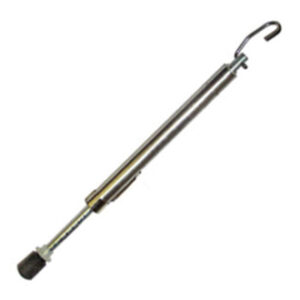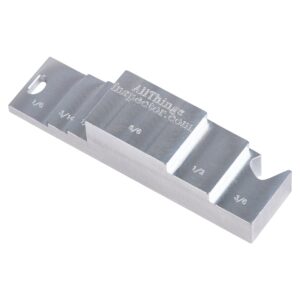Fire Door
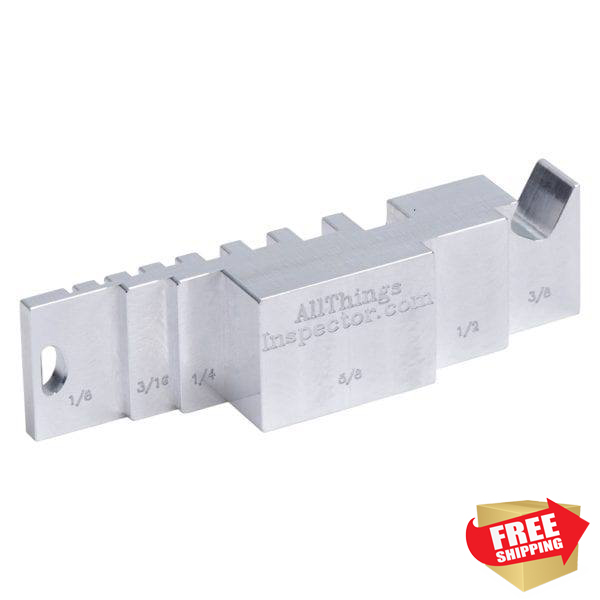
The Best Fire Door Inspection Tool
If you doing Fire Door Inspections and are a door carpenter, inspector, Fire Marshal, IOR you must acquire the Fire Door Inspection Tool to help you save time and check fire-rated doors with more accuracy.
- The Fire Door Gap Gauge is an Easy to Use, Pocket-Sized Device that fits on almost any kind of keychain this way you have it when you need it. It functions as a beer bottle opener and a 3″ measuring tape.
- Created specifically to check clearance demands prior to assessments for Fire Rated Door Assembly by your AHJ.
- The Fire Door Gauge was made with input from several AHJ’s, Fire Marshall’s tradesmen, and also inspectors.
- It is Easy to Read
- Light Enough to Bring Anywhere
- The Door Gap Gauge is CNC machined out of aluminum to really tight tolerances.
- The trendy aspect of The Fire Door tool is that it is a multi-use device that brings convenience.
- Are you a Quality Control, Tradesperson, or Designer that needs to measure that product on the 19th floor? Well, you remain in luck if you have the Fire Door Space Gauge. That very same day you are finishing up your job. The crew chooses to meet at the park as well as have a couple of cold ones. You pull out your Fire Door Gauge and are saved yet again. It is not only made to help save lives but will certainly save you when you at the very least anticipate it. If your time is important you need a Fire Door Gauge.
What if my business is tax exempt?
How to use the Fire Door Inspection Tool?
It can be used with any type of door whether, hollow steel, fire-rated timber, and also lightweight aluminum just to name a few types.
Next, find the measurement part of the gauge required to determine your gap. Place the gauge between the door and also the framework. The scale should fit snug in the gap and also have the ability to move conveniently along the whole length of the void.
Nonetheless, when examining the door gap at the bottom of the door the scale must not travel through when examining the bottom margin.
Door Gauge Specs
- It is portable and easy to use with its machined actions to determine the complying with margins 1/8 ″, 3/8 ″, 1/4 ″, 3/8 ″, 1/2 ″ 5/8 ″, and 3/4 ″ for your required door gaps.
- It also features a material thickness gauge with the capacity to measure the following dimensions 20ga, 16ga, 15ga, 14ga, 1/8 ″, 10ga, 3/16 ″, and 1/4 ″ of sheet products and cord sizes.
- The coolest component is that it flaunts a beer bottle opener as well as connects to your keychain when you need it one of the most.

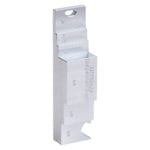

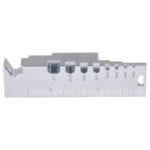







How can a fire rated door help during a fire?
Let’s take a minute to have a better understanding of the importance of fire doors. In the event of an actual fire, these doors can serve an important role in keeping flames and smoke from spreading to different parts of the building. They can also serve as a means of easy escape in case of an emergency.
Fire doors play a vital role in access control and protecting people and property from more than just the outdoor elements. These passive fire protection systems are designed to protect an opening with a fire-rated barrier.
Fire doors are typically used to protect openings in exits, such as fire-rated stair enclosures, fire-rated exit corridors, and horizontal exits. They’re also installed in fire barrier openings that are designed to protect your building and its occupants from specific hazards, as well as compartmentalize your building into specific fire areas
Building and fire codes require fire doors to pass a fire-resistance test that’s conducted by an independent testing agency. The standard test procedure for fire doors can be found in NFPA 252: Standard Methods of Fire Tests of Door Assemblies. The doors are tested as a complete assembly, which includes the door leaf, hinges, the latch, the closing device, and the frame.
All fire doors are subject to fire tests conducted by national test agencies and must withstand the rigors of the fire test.
Fire Door Products
-
ADA Door Pressure Gauge Push-Pull, 0-35lbs
$59.99 Add to cart -
ADA Push Door Pressure Gauge
$29.99 – $89.97 Select options This product has multiple variants. The options may be chosen on the product page -
Fire Door Inspection Tool
$29.95 Add to cart
Some of our Previous Clients Include
















What are some basic requirements for fire rated door assemblies?
- Fire ratings (20/45/60/90/180 minutes) are granted by third-party testing agencies and are labeled on the products.
- Fire rated door assemblies must meet the requirements of the applicable building or life safety code, such as the National Fire Protection Association (NFPA) 80: Standard for Fire Doors and Other Opening Protectives, NFPA 101: Life Safety Code, the International Building Code (IBC) and the International Fire Code (IFC).
- Fire doors are required to be self-closing and positive latching.
- The fire rating of the wall dictates the fire rating of the door.
Standards and Testing – Fire rated doors are tested in accordance with the following standards:
- UL 10B, Fire Tests of Door Assemblies (neutral or negative pressure)
- UL 10C, Positive Fire Pressure Tests of Door Assemblies
- NFPA 252, Standard Methods of Fire Tests of Door Assemblies
These tests and annual fire door inspections ensure that your fire door will work properly in fire conditions.
When inspecting and testing the door for its annual inspection per NFPA 80, it’s important to make sure the door isn’t tied or propped open and check for damage and missing parts. If you don’t already have the best fire door gap gauge to expedite your annual fire door inspection you should get your today?
All fire doors are required to have a label indicating the test organization and the door classification in hours.
In addition, fire doors must have a closing device and latch. The closing device will make sure the door closes properly; the latch will hold the door closed during a fire. If it’s required, exit hardware must be labeled as “fire exit hardware.”
Because fire doors are tested as a complete assembly, field modifications to fire doors are restricted. Signs can only be installed on a fire door using adhesive signs cannot be installed with nails or screws. Also, kick plates may be installed, but with limitations. It’s important to consult with NFPA 80: Standard for Fire Doors and Other Opening Protectives for other field modifications, such as security devices and other hardware installation requirements.
Download our NFPA 80 Fire Door Inspection Checklist.
To ensure that your fire doors are in proper working order make sure you get your fire door inspections annually as required per NFPA 80.
Everything you need to know about Fire Door Assemblies
Everyone’s safety should be the top priority in all building facilities. In the event of a fire, people should be able to navigate safely to get to exit points.
And since you also need to control traffic of people entering and leaving a building, fire doors come in handy, as they can help you save lives.
This article shall educate you on everything you need to know about fire doors so you can help save lives when a fire incident occurs. That said, you may ask yourself…
What are fire doors designed to do?
Just as the name suggests, fire doors help save lives when a fire disaster occurs.
They are designed to withstand harsh external elements, thus preventing fire and smoke from spreading to different parts of the building.
This way, you get to buy time for everyone to evacuate the building before it’s too late. And since fire and smoke can’t spread to other parts of the building, you get to spend less on repairs after the fire incident.
Fire-rated doors also help control traffic flow in and out of a building. For instance, in the event of a fire, the doors protect exit points like fire-rated exit corridors, horizontal exits, and fire-rated stair enclosures.
How can a fire-rated door help during a fire?
As mentioned above, fire doors help save lives when a fire incident occurs since they can resist fire and smoke from spreading to other parts of the building. But just how do they work?
Get this…
Fire doors have ratings that dictate how long a door can hold back the fire and smoke as people evacuate the building.
Some doors can hold back the fire and prevent it from spreading for up to 20 minutes, while others can go as far as 180 minutes. This can only be achieved through the fire-rated barriers designed and tested with the doors.
Determining the fire rating of a door through testing
Because of how bad and destructive fire disasters can be, fire doors need to be tested to ensure they function as required.
Building codes in the US clearly state that the testing should be done with an independent testing agency.
During these tests, fire doors are exposed to different fire rigors and tested as a complete assembly to ensure that all components are fire rated and working as they should.
That said, let’s look at…
Basic requirements for fire-rated door assemblies
A recent study estimated that more than 3000 people in the US die from fire each year. However, these numbers can go down when safety precautions are taken.
This is only achievable when you install fire doors that meet the basic requirements for fire-rated door assemblies. Some of them include:
- Fire doors should be self-closing and self-latching.
- In any given building, the fire rating of the wall dictates the fire rating of the fire door.
- Fire rating from 20-180 minutes should be done with third-party agencies and labeled on their products.
- All fire-rated doors must meet the building’s safety code requirements as dictated by the International Building Code.
Standards used to test fire-rated doors include:
- NFPA 252, Standard Methods of Fire Tests of Door Assemblies.
- UL 10B Fire Tests of Door Assemblies.
- UL 10C, Positive Fire Pressure Tests of Door Assemblies
NOTE: When testing a fire door under the NFPA 252 standards, ensure that the door isn’t propped open or tied. Make sure to also check for damages or any missing parts.
Our door gap gauges can help you quickly and easily get this test done. Get yours today and make your annual fire door inspection easy and seamless.
Let’s have a better look at this tool in detail.
The best fire inspection tool to check for clearance requirements
At AllThingsInspector, we understand that inspectors, door carpenters, fire marshals, and IORs need an inspection tool that they can rely on to check for clearance requirements before the AHJ arrives.
That is why we designed this magnificent Door Gap Gauge.
It is an easy-to-use, pocket-friendly device that can fit almost all types of keychains, so you can carry it everywhere you go.
It features 3” measuring tape and is one of the most ideal tools you will ever use. Its design was created from the input of several AHJs, inspectors, and marshals.
Having it, you can be sure that you are using a tool tested and proven to work by different professionals in the field.
It is also worth noting that it is CNC machined from aluminum. Therefore it is built with really tight tolerances.
The coolest thing about it? You could use it as a bottle opener when popping cold drinks with your friends or colleagues.
How to use the fire door inspection tool
Using the Door Gap Gauge is easy.
First, find the part on the gauge that you will use to measure the gap on your door. (You can use it on any type of door, whether lightweight aluminum, hollow steel, or fire-rated timber)
Once that is done, place the gauge between the door and the frame you are measuring. You will know everything is okay when the scale fits snugly and is able to move seamlessly along the length of the void.
NOTE: The scale should not move freely when measuring the gap at the bottom of the door
Door gauge specs
Here are some cool specs about our Door Gauge:
- It features a material thickness gauge that can measure dimensions ranging from 20ga, 16ga, 15ga, 14ga, 1/8 “, 10ga, 3/16”, and 1/4” cord and sheet sizes.
- It is light, portable, and easy to use as it can determine the compliance with margins 1/8 ”, 3/8 ”, 1/4 ”, 1/2 ”, 5/8 ”, and 3/4 ” of your door gap.
- It also features a bottle opener and can be linked to your keyholder, allowing you to carry it everywhere.
One thing you will notice when you get yourself one of our cool Door Gap Gauges is how time-saving they can be. Just a few minutes on-site, and you will be ready for the AHJ.
However, ensure that the fire-rated door label is visible and legible, as it contains all the vital information your AHJ will need when inspecting your door.
Let’s have a brief look at what fire-rated door labels are to get a better understanding.
What are fire-door labels?
Just as the name suggests, fire-rated door labels contain all the most vital information for a safe and fully functioning fire door.
The ICC Digital codes stipulate the following door labeling requirements:
- The name of the manufacturer of the door.
- Name of the third-party inspection agency that tested the door.
- Whether the fire door can prevent smoke and air leakages or not.
- Fire protection rating.
- The maximum temperature that the door can transmit.
If your fire door has one that has been painted over or is missing, you must contact a third-party agency to replace it.
Conclusion
Fire doors are crucial for every facility. When in place, they can help save lives when a fire emergency occurs. Because of that, it is crucial that they are tested regularly to ensure that they are fully functional.
Our Door Gauge comes in handy here as it helps you save time when testing for gaps along your door margins. It is very light to carry around and can be linked to your keyholder so that you can carry it everywhere you go.
Best part? It can also act as a bottle opener, making it a must-have tool. Get it today and experience how easy your life can be!
You can also grab a free NFPA 80 Fire Door Inspection checklist here.
Frequently asked questions about fire doors
Will my fire doors remain efficient and functional if I make field modifications?
Since fire door assemblies are tested as a whole, making any modifications could tamper with the efficiency and functionality of the door. Because of that, you are restricted from making any modifications as it could compromise the security of people accessing the building.
The only modification allowed is adding signs, which can only be installed using adhesives. Kick plates can also be installed, but check with the NFPA 80 requirements before taking any step.
Must my fire doors have a fire door label?
Because fire door labels contain very crucial information, it is, therefore, necessary that every fire door has one installed. When there is an emergency, the label will help keep people in the building safe and facilitate easy evacuation.

